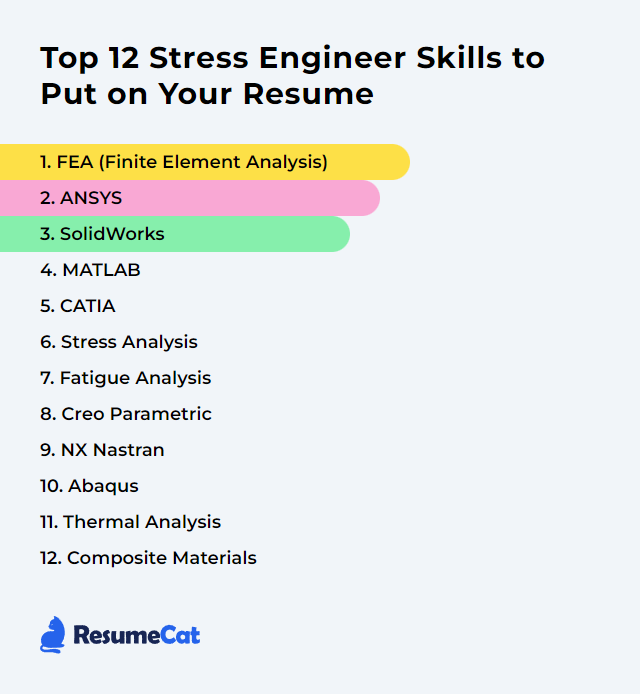Top 12 Stress Engineer Skills to Put on Your Resume
In the dynamic field of stress engineering, showcasing the right blend of technical expertise and soft skills on your resume can significantly elevate your job prospects. This article explores the top 12 skills stress engineers should highlight to stand out in a competitive market and grow into more complex, rewarding work.
Stress Engineer Skills
- FEA (Finite Element Analysis)
- ANSYS
- SolidWorks
- MATLAB
- CATIA
- Stress Analysis
- Fatigue Analysis
- Creo Parametric
- NX Nastran
- Abaqus
- Thermal Analysis
- Composite Materials
1. FEA (Finite Element Analysis)
Finite Element Analysis (FEA) is a computational technique used by stress engineers to predict how structures respond to forces by dividing a structure into smaller elements and analyzing their behavior under given conditions.
Why It's Important
FEA is crucial for a Stress Engineer because it predicts structural behavior under varied loads with precision, supports safety and reliability decisions, and cuts the need for costly physical prototypes through virtual validation and optimization.
How to Improve FEA (Finite Element Analysis) Skills
Sharpen FEA by tightening modeling discipline and validation rigor.
Mesh refinement: Target fine meshes where gradients spike; run convergence studies rather than guessing.
Trustworthy materials: Use verified properties, temperature- and rate-dependent when needed. If data is uncertain, bracket it and document assumptions.
Realistic boundaries: Mirror how parts are loaded, constrained, and assembled. Reconcile models with drawings, test setups, and how the product is actually used.
Right solver, right physics: Pick linear vs. nonlinear, static vs. transient, implicit vs. explicit based on contact, plasticity, or dynamics involved.
Verify and validate: Cross-check with closed-form math, standards, and test data. Calibrate models before you extrapolate.
Sensitivity and uncertainty: Probe which inputs sway outputs; quantify confidence bands.
Peer review: Fresh eyes catch shaky constraints, dodgy mesh transitions, and misapplied loads.
How to Display FEA (Finite Element Analysis) Skills on Your Resume
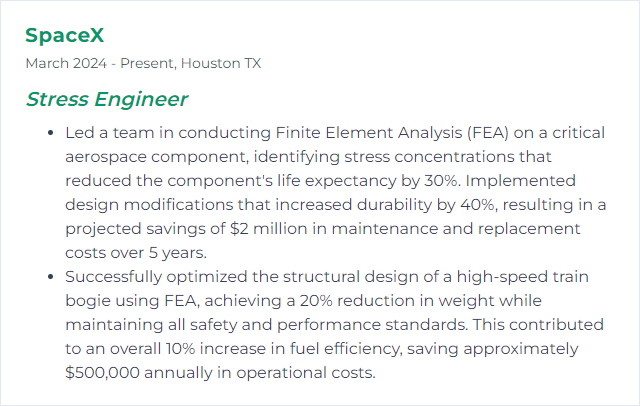
2. ANSYS
ANSYS is a comprehensive simulation suite used to perform FEA for structural, thermal, and dynamic analyses, helping engineers predict response, refine designs, and verify margins.
Why It's Important
ANSYS equips a Stress Engineer with robust solvers and workflows to analyze complex assemblies, reduce risk early, and iterate designs for safety, performance, and cost.
How to Improve ANSYS Skills
Ground the fundamentals: Become fluent in Workbench and Mechanical APDL. Understand contacts, constraints, meshing, and solution controls.
Specialize: Dive into nonlinearities, modal/transient dynamics, and fatigue modules relevant to your products.
Replicate real problems: Build models from field data and test setups; benchmark against measured results.
Template smart: Create reusable project templates and named selections to speed consistent setups.
Stay current: New releases often bring better contact, meshing, and HPC features—adopt what actually helps your workloads.
Document rigorously: Keep modeling checklists, solver settings, and correlation notes. Future-you will thank you.
How to Display ANSYS Skills on Your Resume

3. SolidWorks
SOLIDWORKS is a CAD and simulation platform for creating 3D models and running structural checks, handy for early stress insights and design-for-strength decisions.
Why It's Important
For a Stress Engineer, SOLIDWORKS Simulation speeds quick what-if studies, sanity checks, and geometry tweaks that reduce overdesign and prevent late-stage surprises.
How to Improve SolidWorks Skills
Master modeling essentials: Clean, parametric sketches, robust mates, and feature order reduce simulation headaches.
Focus on Simulation: Learn contacts, connectors, shells/beams, and result interpretation. Validate with hand calcs.
Certify: Pursue Simulation-focused certifications to structure learning and prove proficiency.
Follow updates: Track new meshing, solver, and result visualization capabilities.
Practice breadth: Tackle parts, thin-walled shells, weldments, and assemblies with mixed constraints.
Engage events: 3DEXPERIENCE World and user groups often share techniques and pitfalls worth adopting.
How to Display SolidWorks Skills on Your Resume
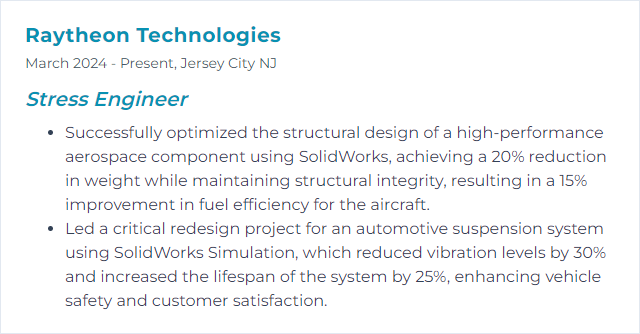
4. MATLAB
MATLAB is a high-level programming and numerical computing environment used for modeling, simulation, data processing, and visualization in structural and materials analysis.
Why It's Important
It accelerates numerical workflows, lets you prototype algorithms fast, interrogate large datasets, and build custom tools for fatigue, signal processing, and optimization.
How to Improve MATLAB Skills
Vectorize: Replace loops with matrix operations for speed and clarity.
Profile and optimize: Use the profiler, preallocate arrays, and pick appropriate data structures.
Parallel and GPU: Offload heavy tasks across cores or GPUs when analyses balloon.
Toolboxes that matter: Lean on Optimization, Curve Fitting, Statistics, and Signal Processing for engineering workflows.
Build reusable functions: Package utilities for unit conversions, S-N data handling, and material curve fitting.
Script your pipeline: Automate post-processing of FEA outputs into clean reports and plots.
How to Display MATLAB Skills on Your Resume

5. CATIA
CATIA is a multi-platform CAD/CAE suite from Dassault Systèmes. For stress engineers, it brings advanced surfacing, complex assemblies, and built-in simulation workbenches to model and assess structural behavior.
Why It's Important
It handles large, intricate models with precision and ties design-to-analysis workflows together, reducing translation errors and rework.
How to Improve CATIA Skills
Core workbenches first: Part Design, Assembly, Generative Shape Design—clean geometry drives reliable analysis.
Generative Structural Analysis: Learn loads, restraints, connections, and post-processing deeply; correlate to tests.
Automate: Use macros and scripting to standardize meshing, naming, and export steps.
Industry scenarios: Practice with aerospace/automotive components: thin shells, composites, bolted joints, contacts.
Version awareness: Track platform updates that affect meshing, composites, or co-simulation.
How to Display CATIA Skills on Your Resume

6. Stress Analysis
Stress analysis determines internal forces, stresses, and deformations under applied loads so components meet safety, durability, and performance targets.
Why It's Important
It’s the backbone of structural integrity decisions—preventing failures, informing materials and geometry choices, and satisfying standards and certification.
How to Improve Stress Analysis Skills
Foundations: Solid mechanics, failure theories, fracture mechanics, and stability—know the limits of closed-form versus numerical.
Tool fluency: Build proficiency in multiple solvers to match the physics at hand; benchmark results across tools when stakes are high.
Material reality: Incorporate plasticity, creep, rate effects, and temperature dependence when relevant.
Standards-savvy: Apply applicable codes and standards; document load cases, partial factors, and acceptance criteria.
Correlation mindset: Test early, iterate models, and record discrepancies and fixes.
Design for inspection: Anticipate hotspots and propose features that ease NDI and condition monitoring.
How to Display Stress Analysis Skills on Your Resume
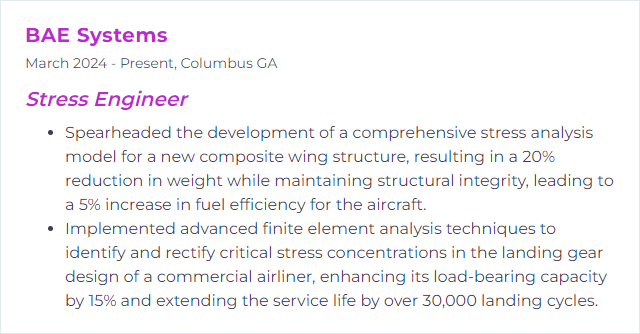
7. Fatigue Analysis
Fatigue analysis predicts life and failure under cyclic loading by assessing stress ranges, mean stresses, and damage accumulation over time.
Why It's Important
Most structures fail in fatigue, not static overload. Predicting crack initiation and growth safeguards reliability and reduces costly downtime.
How to Improve Fatigue Analysis Skills
Accurate S-N and ε-N data: Use material data matched to surface finish, size, temperature, and environment.
Load spectra realism: Capture duty cycles, mean stress effects, multiaxiality, and sequence effects.
Hotspot fidelity: Mesh and model notches, weld toes, and contact edges carefully; extract structural stress properly.
Appropriate models: Pick the right life method—stress-life, strain-life, or fracture mechanics—based on regime and plasticity.
Safety factors and scatter: Reflect data variability and uncertainty, then justify chosen margins.
Test to build trust: Coupon and component testing validate assumptions; update models when reality disagrees.
Manufacturing effects: Account for residual stresses, weld quality, surface treatments, and defects.
How to Display Fatigue Analysis Skills on Your Resume
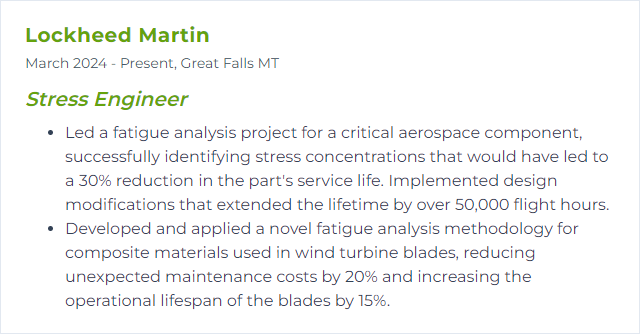
8. Creo Parametric
Creo Parametric is a 3D CAD platform for modeling, analysis, and optimization—useful for stress engineers building precise geometry and running integrated simulations.
Why It's Important
It supports robust, parametric models, embedded simulation workflows, and design variants that respond quickly to analysis findings.
How to Improve Creo Parametric Skills
Modeling discipline: Intent-driven features, robust references, and clean datums reduce rebuild and meshing issues.
Simulation know-how: Learn structural, thermal, and modal analyses within the environment; validate with benchmarks.
Advanced surfacing: For thin shells and aerodynamic shapes, precise surfaces matter.
Design optimization: Apply parametric studies, sensitivity analyses, and goal-driven optimization.
Shortcuts and automation: Mapkeys, templates, and start parts speed consistent setups.
Release notes: New versions often improve meshing and contacts; adopt changes that improve accuracy or speed.
How to Display Creo Parametric Skills on Your Resume

9. NX Nastran
Simcenter Nastran (formerly NX Nastran) is a high-fidelity FEA solver for structural analysis, vibration, buckling, heat transfer, and more—used widely where precision and solver breadth matter.
Why It's Important
It delivers trusted solution sequences, scalable performance, and comprehensive element libraries that help predict real behavior under complex loading.
How to Improve NX Nastran Skills
Modeling best practices: Element selection, quality checks, proper constraints, and contact definitions come first.
Leverage SOLs: Choose solution sequences aligned to physics—modal, direct transient, nonlinearity, optimization.
Pre/post fluency: Use a capable pre/post tool to audit element quality, loads, and results extraction consistently.
Optimization workflows: Explore sizing, shape, and topology optimization tied to design constraints.
HPC and scaling: Use multi-core and distributed runs; profile models to remove bottlenecks.
Correlation culture: Anchor models with test data; iterate until predictions tighten.
How to Display NX Nastran Skills on Your Resume

10. Abaqus
Abaqus is a comprehensive FEA suite known for nonlinear analysis, contact robustness, and advanced material modeling across metals, rubbers, composites, and more.
Why It's Important
For a Stress Engineer, Abaqus excels when behavior gets messy—large deformation, plasticity, complex contacts, and coupled physics.
How to Improve Abaqus Skills
FEA fundamentals first: Good elements, stable constraints, and convergence strategies beat guesswork.
Nonlinear mastery: Control increments, stabilization, and contact formulations; interpret warnings, not just errors.
Material fidelity: Fit elastoplastic and hyperelastic models to test data; verify rate and temperature effects.
Python scripting: Automate pre/post steps, parameter sweeps, and report generation.
CAE hygiene: Version models, document assumptions, and save solver settings tied to results.
Experiment and compare: Try alternate contact and element options; pick what correlates best.
How to Display Abaqus Skills on Your Resume
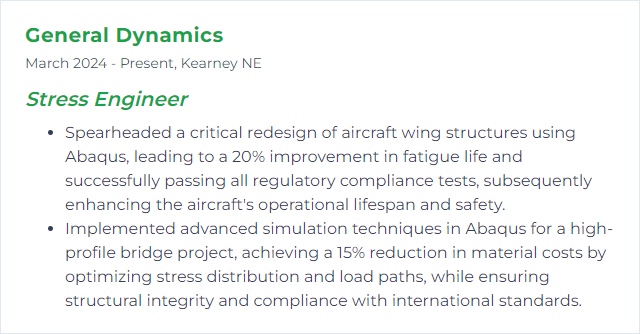
11. Thermal Analysis
Thermal analysis studies how temperature fields drive expansions, stresses, and distortions—alone or coupled with structural loads.
Why It's Important
Temperature swings can quietly erode margins. Understanding heat flow and thermal stresses prevents warping, cracking, and premature failures.
How to Improve Thermal Analysis Skills
Accurate properties: Use temperature-dependent conductivity, specific heat, emissivity, and convection coefficients.
Mesh where gradients bite: Refine in hotspots near heat sources, interfaces, and sharp geometry changes.
Real boundaries: Get convection, radiation, contact conductance, and duty cycles as close to reality as practical.
Coupled problems: Run thermo-structural analyses when expansion drives stress; consider transient scenarios.
Sensitivity checks: Vary uncertain inputs and bracket outcomes to understand risk.
Test correlation: Use thermocouples, IR, or chamber tests to validate assumptions and tune models.
How to Display Thermal Analysis Skills on Your Resume
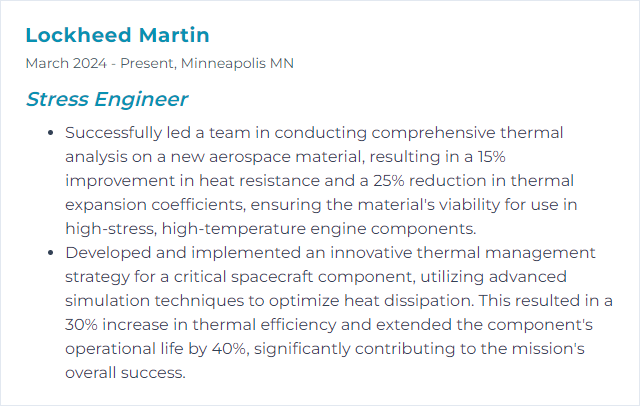
12. Composite Materials
Composite materials combine two or more constituents to achieve properties single materials can’t—high strength-to-weight, tailored stiffness, and environmental resistance.
Why It's Important
They unlock lighter, tougher structures with directional performance, ideal for aerospace, energy, automotive, and beyond.
How to Improve Composite Materials Skills
Fiber architecture: Choose fiber type, volume fraction, and layup angles to meet load paths and stiffness targets.
Matrix selection: Match resin chemistry to temperature, chemicals, moisture, and toughness needs.
Hybrid designs: Blend fiber types to balance stiffness, impact resistance, and cost.
Nano-toughening: Add nanoparticles or veils to boost fracture toughness and thermal stability when justified.
Manufacturing optimization: Use processes that curb voids and fiber wrinkling; control cure cycles and compaction.
Damage tolerance: Design for barely visible impact damage, delamination arrest, and inspectability.
Environmental conditioning: Test under humidity, UV, and thermal cycling to understand long-term knockdowns.
How to Display Composite Materials Skills on Your Resume

